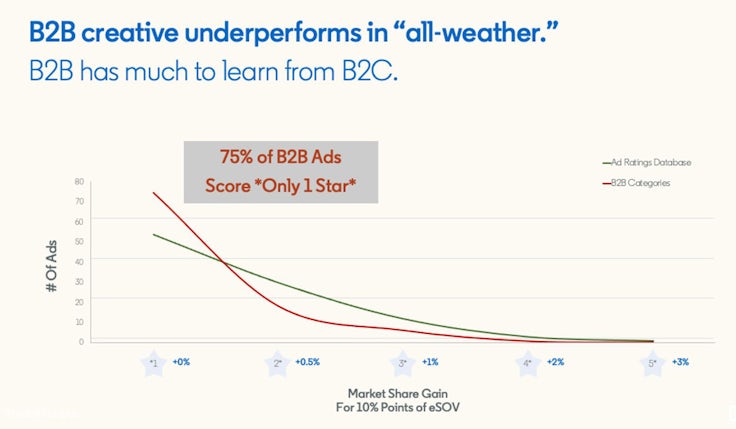Majority of B2B advertising is ‘ineffective’
7 min read The majority of B2B creative “ineffective” according to new research from the LinkedIn B2B Institute and market research agency System1.
The majority of B2B creative “ineffective” according to new research from the LinkedIn B2B Institute and market research agency System1.
Of the 1,600 B2B ads shown to a sample of 6 million people worldwide over the past four years, 75% scored one star or less on System1’s FaceTrace emotional measurement tool.
In this context, a one-star rating means a piece of advertising is contributing zero in terms of long-term market share growth. A one-star rated ad essentially means the brand is entirely reliant on out-spending the category, rather than benefitting from the strength of the creative.
None of the 1,600 B2B ads viewed in the research attained a maximum score of five stars. Five-star ads, which score highly on emotion, fluency and intensity, have been found to help a brand grow by an average of 3% in the long term, aiding the excess share of voice and category spend.
The principles of a five-star ad, as defined by System1, are a strong story arc, characters, soundtrack, emotion and a fluent device which drives brand recognition. However, the research suggests B2B advertising is failing to deliver on many of these elements.
In fact, an inability to see creativity as a major profit multiplier could mean B2B brands are sacrificing their chance at long-term, sustainable growth, according to global lead at the LinkedIn B2B Institute Jon Lombardo.
“Marketing in B2B in many cases already isn’t taken seriously by product, engineering or sales because it isn’t seen as the money end of the business. When you put out that sort of [one-star] creative it only weakens your case,” he states.
“It’s a bit of a Catch 22, because you’re trying to tell very rational people that you need to run very emotional advertising and that isn’t a very easy thing to do.”

Fellow LinkedIn B2B Institute global lead, Peter Weinberg, believes a major reason B2B brands are failing to commit to creativity is down to the way their organisations are run.
Whereas many B2C firms are considered to be marketing led, this is rarely the case in the B2B sector where the focus is typically on being product, engineering or sales driven.
“Product people in particular lean more towards this more rational type of communication where we just have to articulate the product’s benefits and features and, if it’s a great product, of course our customers will buy it,” Weinberg states.
“B2C marketers have the ability to act more freely in the creative direction, whereas B2B marketers have to convince other people in the organisation to take what may seem to them a more frivolous or unusual approach to communications.”
Lombardo agrees that B2B companies are “almost never marketing led” and the dominant mindset is a right-brained ideology focused on rational arguments, rather than the power of emotion. However, B2B marketers themselves can also underestimate the amount of emotion tied up in how we think about our jobs, relating to confidence, survival and even our own identities.
“The irony is your job is your most emotional experience, but you’re not allowed to be vulnerable at your job. You’re not allowed to admit fear at your job. As a result, this filters into the advertising, so it’s always very rational and confident,” notes Lombardo.
Our attitude to modern business is fuelling the misconception that a B2B purchase is a far more rational process than it really is. B2B marketers may think their customers are obsessed with specifications, pricing and making objective decisions, when in fact there will be emotions at play. In many cases the stakes are very high, which only adds to the emotion.
There’s a lot more on the line in a B2B decision. There’s a much greater cost to the buyer of making a mistake, which means these are more emotional decisions.
Peter Weinberg, LinkedIn B2B Institute
“If you buy a Coke and it was a bad decision so you throw it out, you lost a dollar. If you choose the wrong cloud computing vendor you could cost the company billions of dollars and lose your job,” Weinberg says.
“If you lose your job in America you lose your health insurance, you can’t feed your family. There’s a lot more on the line in a B2B decision. There’s a much greater cost to the buyer of making a mistake, which means these are more emotional decisions, not less emotional decisions.”
He points to market research as another issue. B2B brands, Weinberg argues, tend to ask customers what they think, not how they feel. When asked why they chose a particular cloud computing solution, customers may give a rational explanation rather than admitting it was the safe choice and they didn’t want to get fired.
“All of these market research tools and surveys overemphasise the degree to which rational processing influences our decisions,” he explains. “Then the marketers follow the research and develop very rational advertising even though it’s not really what was driving the decision and it’s not even really how advertising works.”
Make a commitment
Lombardo and Weinberg believe this new research gives B2B marketers credible data to present to their sales, product or engineering teams to make the business case for advertising that will drive future growth.
They point to the notion of creative commitment, which has been found to heavily influence a campaign’s effectiveness. A term coined by effectiveness experts Peter Field and James Hurman, creative commitment is defined as a measure of media budget, duration and the number of media channels applied to a creative campaign. Committing to the creative essentially helps the advertising become memorable.
“The fundamental thing is about being remembered. The money is a function of the memory, the memory is driven by the emotions and is driven by the amount of time you run [the creative],” says Lombardo.
“You have to explain how emotion is rational and if you can explain how emotion is rational then you can make a very clear case to the finance team, or the engineering team, about how it works.”
Weinberg points to the importance of long-term thinking with reference to the slew of ads produced by both B2B and B2C brands that made specific reference to Covid-19.
What role will effectiveness play in the post-Covid recovery?
“If you’re thinking long term you realise it doesn’t even matter if you produced a really good coronavirus ad that scores really highly on emotion and fluency, because fundamentally it’s a once in a 100-year pandemic and it’s going to immediately become outdated,” he argues.
“The idea of using commitment as a kind of litmus test to say to yourself ‘Could I run this same ad or creative concept for the next 100 years?’ is a much better way to make decisions and get repeat value out of your creative. Otherwise you’re constantly having to pull rabbits out of a hat and you’re not building those repeat memory structures that you need to refresh over time.”
As well as the need to commit to the creative and evoke emotion in order to stay memorable, B2B brands are guilty of underestimating the opportunity provided by characters, one of the elements defined by System1 as a hallmark of a five-star ad.
Characters are memorable, can carry a story over an extended period of time and bring something to the advertising that consumers can emotionally relate to. Yet despite the clear advantages, characters rarely make an appearance in B2B advertising.
Weinberg explains that every B2B client he and Lombardo advise to invest in a brand character finds a “thousand reasons” why they can’t possibly have one, such as that it will dilute the seriousness of their brand, or the business won’t buy into a “silly frivolous tactic”.
You have to explain how emotion is rational and if you can explain how emotion is rational then you can make a very clear case to the finance team.
Jon Lombardo, LinkedIn B2B Institute
“In B2C you wouldn’t even sound insightful if you said you should create a character, everyone has a character. In B2B I could literally count on one hand the number of brands that have really invested in a brand character,” says Weinberg.
“There’s Salesforce that’s done it and Intuit. HPE had an IT monster for a little while, but it’s a very rarely used tactic in B2B and it’s an extremely effective tactic. We view that as a super undervalued approach to developing better creative.”
To push through change and bring the wider business on board with the need for emotional storytelling and left-brained thinking, B2B marketers should ditch terminology like ‘brand purpose’ and ‘brand love’, and start speaking the language of money, Weinberg adds.
“Creative is always going to be the most scrutinised thing a marketer invests in because it seems like ‘arts and crafts’, but what this research really shows is that creative is the biggest driver of financial performance and is a major multiplier on profits,” he adds.
“The data supports that if you do those things you get more market share growth. It really starts with marketers being more commercial. When they go in to talk to finance and sales, it’s not their opinions it’s the evidence that if you allow us to build a character we’ll increase our fluency, which will increase our market share. It’s connecting these marketing inputs to these financial outputs. That’s where it starts.”
The LinkedIn B2B Institute’s webinar presenting the full results of the research can be watched here.





